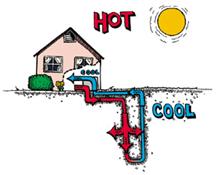Tapping into the Earth to Heat and Cool Your Home with Geothermal Energy
By Mark J. Donovan
|
|
Geothermal heating and cooling systems are growing in popularity as they offer the ultimate in eco-friendliness and energy efficiency. Though man has taken advantage of geothermal heat for thousands of years, it has only been in the last few decades that geothermal has become practical for commercial and residential heating and cooling purposes. With today’s geothermal heating and cooling technology it is possible to heat or cool a moderate size home for around $1 a day. Unlike other heating and cooling systems, geothermal HVAC systems do not require oil, gas, or propane to operate.
All they require is a small amount of electricity to run a well pump and a heat pump. Geothermal heating and cooling systems also operate much more efficiently than oil and gas furnaces. |
A geothermal heating and cooling system, for example, can operate up to 75% more efficiently than an oil furnace based heating system.
How Geothermal Heating and Cooling Systems Work
It is important to first understand that the earth maintains a fairly constant temperature. You may already have recognized this fact if you have a basement that sits mostly below soil grade. Even in the winter the temperature in a basement rarely dips below 50o (F). It is the geothermal energy surrounding the foundation that keeps the basement reasonably warm. Geothermal heating and cooling systems work by tapping a bit deeper into the earth to extract heat from it and to transfer it into your home.
Geothermal Heating and Cooling Benefits
Besides being extremely energy efficient, geothermal HVAC systems also cause minimal environmental impact, as they effectively require no fossil fuels to operate.
In addition, they require little space within the home, particularly when you consider the fact that they are providing both heating and cooling. A typical geothermal HVAC system consists of a heat pump and heat exchanger that combined requires the space of a small refrigerator. They also are extremely quiet as there are no roaring furnace sounds. Also, with an open loop standing vertical column well geothermal system, minimal land is required.
| Geothermal Heating and Cooling System Costs
Geothermal heating and cooling systems are not inexpensive to install. You can expect to pay somewhere between $20 and $35K to install one, depending upon the size of your home and the local terrain. Drilling a standing vertical column well or trenching in a horizontal piping system is an expensive endeavor. In addition, geothermal heat pumps are about twice the cost of a regular heat pump system that supports air conditioning as well. This said, the cost savings compared to operating an oil or propane heating system, and an electric air conditioning system, is very high. |
 |
For example, with a 2,000 square foot home utilizing a geothermal heating and cooling system, you could expect to see annual operating costs less than $400, whereas with a conventional oil furnace system and a couple of electrically operated air conditioners you could easily pay $2,500 in annual energy costs. In addition, a geothermal HVAC system is eligible for a 30% federal government tax credit for the cost of the system. Consequently you could expect to recoup your initial investment in a geothermal HVAC system in as little as 10 years, in a retrofit installation. In a new home construction project the timeline could be much shorter.
In addition to the annual energy cost savings, the market value of a home with an installed geothermal heating system would also be expected to be higher. Potential homebuyers seeing the lower annual operating energy costs for the home will undoubtedly recognize the value as they evaluate the total annual costs (mortgage, property taxes, insurances, and utilities) of owning the home.
So if you have plans to build a new home, or have plans to install a new heating and cooling system, you may want to take a closer look at geothermal HVAC systems. They’re return on investment as well as their eco-friendly benefits may just outweigh their higher installations costs for your home.
For information on Restoring Baseboard Heating Element Covers, see the Restoring Baseboard Heating Element Covers eBook from HomeAdditionPlus.com. The Restoring Baseboard Heating Element Covers Ebook provides easy to understand, step-by-step instructions, on how to restore Baseboard Heating Element Covers so that they look new again. Pictures are included for every key step in the process.
For information on how to maximize a wood stove’s heating efficiency, see HomeAdditionPlus.com’s Installation of Hood over Wood Stove eBook.
Related Information
- Hot Water Baseboard Heating Problems
- Electric versus Hydronic Baseboard Heating
- Common Hot Water Heater Problems
Additional Heating and Cooling Resources from Amazon.com
 |
 |
Free Heating and Cooling Price Quotes with No Obligation!
Fill out our 3-5 minute quick and easy form, and receive a free price quote on heating & cooling from one of our pre-screened and licensed HVAC contractors. This process is free and there is no obligation to continue once you receive your heating & cooling price estimate.

